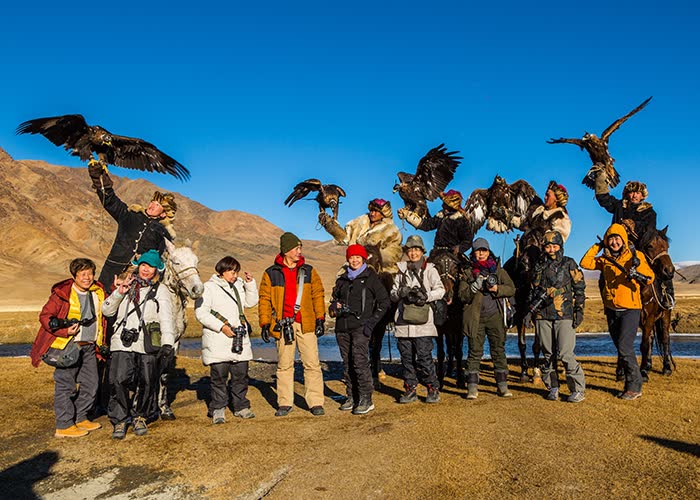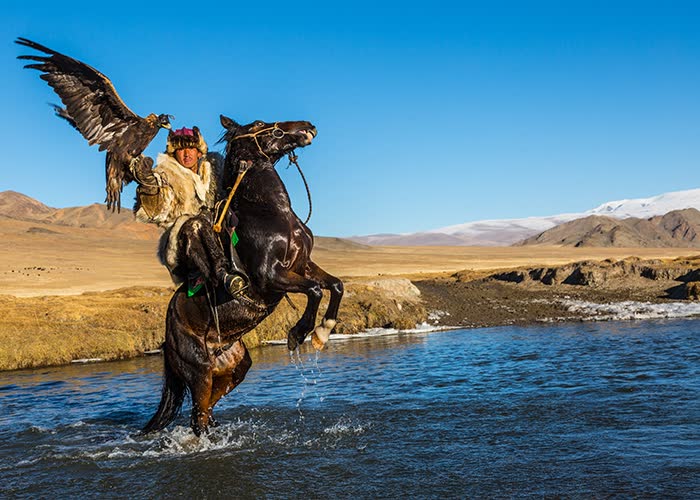HOW AN EAGLE FESTIVAL IS CHANGING TOURISM IN MONGOLIA
HOW AN EAGLE FESTIVAL IS CHANGING TOURISM IN MONGOLIA
MONGOLIA DRAWS ADVENTUROUS TRAVELERS WITH ITS PRISTINE NATURE AND UNCOMPROMISED CULTURE. THE COUNTRY'S INCREASINGLY POPULAR GOLDEN EAGLE FESTIVAL IS TRYING TO FIGURE OUT HOW TO MAINTAIN THOSE NOW THAT IT’S IN THE SPOTLIGHT.

I’m standing on a grassy plain, encircled by mountains, in one of the most remote places in the world.
And somehow, I thought it would be more crowded.
I’ve come to Mongolia for the 20th anniversary of the Golden Eagle Festival, held every October in the far western province of Bayan-Ölgii, where the country borders Russia, China, and Kazakhstan. I’m not the only one: Before the next two days are over, nearly 1,500 visitors will kick up the dust on this sprawling expanse. But right now, a little before 10 a.m., the field is serene.
Within the hour, tour operators will unload a few dozen SUVs full of Patagonia- and North Face–bundled travelers. Local visitors will accumulate as the day goes on, arriving by car or horse or motorcycle or camel. Some will carry sparkly cell phones; some will wear jeans and light jackets, and at least one will be in a hooded sweatshirt printed with a swoop and the word Neki. Others will be in traditional Mongolian Kazakh winter dress: enormous fur coats and colorful peaked hats ringed with fur. And 124 of them—the oldest an 82-year-old man, the youngest a 10-year-old girl—will be eagle hunters. The Golden Eagle Festival has occurred every year since 1999.
THE EAGLE HUNTRESS EFFECT

In 2016, a documentary called The Eagle Huntress drew people’s attention to Mongolia in a way that little else had since Genghis Khan used it as his base for building the largest contiguous empire in history. The film tells the story of another Mongolian warrior of sorts: a smiling, rosy-cheeked 13-year-old girl named Aisholpan, who defied gender convention to practice—and excel at—the ancient Mongolian-Kazakh tradition of hunting with golden eagles.
Like her predecessors, Aisholpan climbed a mountain to find her eaglet (mothers usually foster only one of their litter, leaving the others to fend for themselves), then took it home to shelter, hand-feed, and train. (As is the custom, in about 10 years, Aisholpan will hold a ceremony to release her eagle back into the wild to live for another two decades.) Mongolia was suddenly on the international stage, and the festival—which had been quietly rolling along for 18 years at that point—was smack in the middle of the spotlight. I met two Australian women who’d been planning a trip to China when they stumbled on the movie; they added a week so they could be here. In my own tour group of 12, more than half had come specifically for the festival.
Golden eagles get their flashy name from their not-so-flashy collar of lighter brown feathers. They are not rare—they can also be found in Mexico, the western United States, northern Africa, and Europe—but their ubiquitousness in no way makes them ordinary. With a wingspan of about 8 feet and a weight of roughly 15 pounds, they can dive at speeds up to 200 mph and are capable of taking down a full-grown sheep. Here in western Mongolia, they share the vast, harsh, often-subzero landscape with the nomadic Kazakh hunters, and the relationship is symbiotic: The humans get a swift, sharp-eyed predator to hunt small prey for meat and fur. The eagles get a surrogate parent and steady food, care, and shelter for the first third of their lives.
This link between eagle and hunter goes back centuries. But by the late 1990s, only about 40 Mongolian Kazakh families still had eagles. The tradition—under threat from modernity and a disinterested younger generation—was dying.
EAGLES AMONG US

Although the festival pays tribute to a hunting tradition, no actual hunting takes place, despite what some websites say. On the first day, each participant rode a horse onto a field at the foot of a small mountain, while a partner climbed up the rocky incline with the eagle. When the partner released the bird, the hunter circled his or her horse, whooping in a personalized call intended to draw the eagle to the hunter’s arm. A panel of local government officials and VIPs graded them on how quickly and elegantly that happened, along with assigning points for the beauty of their costumes and their horsemanship. (This seemed fairly subjective, but even as a casual spectator, it was possible to pick out the nuances in skill.)
On and off the field, the crowd went wild for 14-year-old Akhelik, a huntress in a bright white fur hat who caught her eagle in 11 seconds. (As I found out later, some mistook her for the star of The Eagle Huntress, who was away at school this year.) Another clear favorite was tiny 10-year-old Aimulder, whose father rode alongside to help with the weight of her eagle. Later, through a translator, she told me she had been training since she was four. Her father and her grandfather were both eagle hunters, so she wanted to be one, too.
At the end of the two-day festival, the top three scorers won prize money and medals, shiny medallions on rainbow ribbons placed reverentially around their necks—and the necks of their eagles, too. Teenage Akhelik took home third place. Little Aimulder earned an honorable mention award.
The festival has developed to be more than just the eagle competition. Each day, locals set out mats and tables to sell their wares in a makeshift market: handmade felt shoes, embroidered vests, and fox-fur hats with faces of the animals still intact. There was even a tent selling pizza and one with a sign that touted “Nomadic Coffee.”
In another area, people built simple carnival games, and a friend and I lost a couple tugriks trying to toss rings onto pegs. Nearby, archers in colorful coats showily pointed their blunt arrows at the sky and then thudded them quietly into the ground where targets were marked. Just beyond the arrows’ reach, their fellow bowmen jeered in what was unmistakably the Kazakh version of trash talk. A small local boy next to me seemingly loved every second of this. Mouth hanging open in awe, he ping-ponged his head back and forth trying to follow the arrows.

MONGOLIA RISING

More than half of all Mongolians live nomadically in round, movable tent-homes called gers. They relocate in spring to find pasture for their cattle and in winter to find protection from the piercing winds and -40 degree weather. To meet these nomads—to interact with them at the festival and to be welcomed into their homes with fried bread and butter from their own cows, as we were on my tour—is something special; this peek at the culture is a draw for visitors to the country. Whenever I asked another traveler “Why Mongolia?” I got the same answer: nomads, nature, and the eagle festival.
It’s not surprising, then, that while The Eagle Huntress drew attention to the Golden Eagle Festival, tourism to Mongolia has been growing as a whole. In 2000, just 150,000 tourists visited the country, but by 2008, arrivals had jumped to 446,000, thanks to a concerted government effort to build and promote tourism. By 2018, the number was 529,000, and in 2019, it rose to an impressive 577,000—though still shy of the government’s goal of attracting 1 million by 2020, via efforts like tax breaks for high-rated hotels and eliminating tourism licenses. Currently, most travelers come from neighboring Russia and China, followed far behind by South Korea, Japan, and the United States.
Mongolia is one of the least populated countries in the world, with 3 million people living in 600,000 square miles. (By comparison, France, one-third the size of Mongolia, saw 90 million tourists in 2018.) Yet despite all the space, its relatively newfound attention has meant the country is at a delicate crossroads. There is a drive to ramp up tourism, yes, but the question officials are wrestling with is how to do that responsibly—especially when the things that draw travelers to this country are the very things that can be endangered by them: pristine nature and an authentic nomadic culture largely undiluted by Western influence. These same issues are at play at the festival, albeit on a smaller scale.